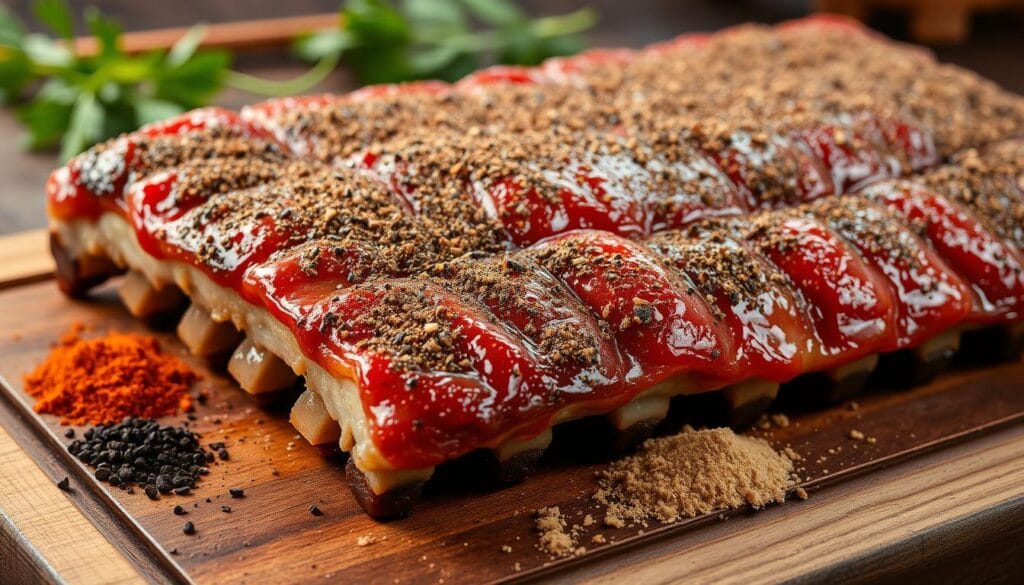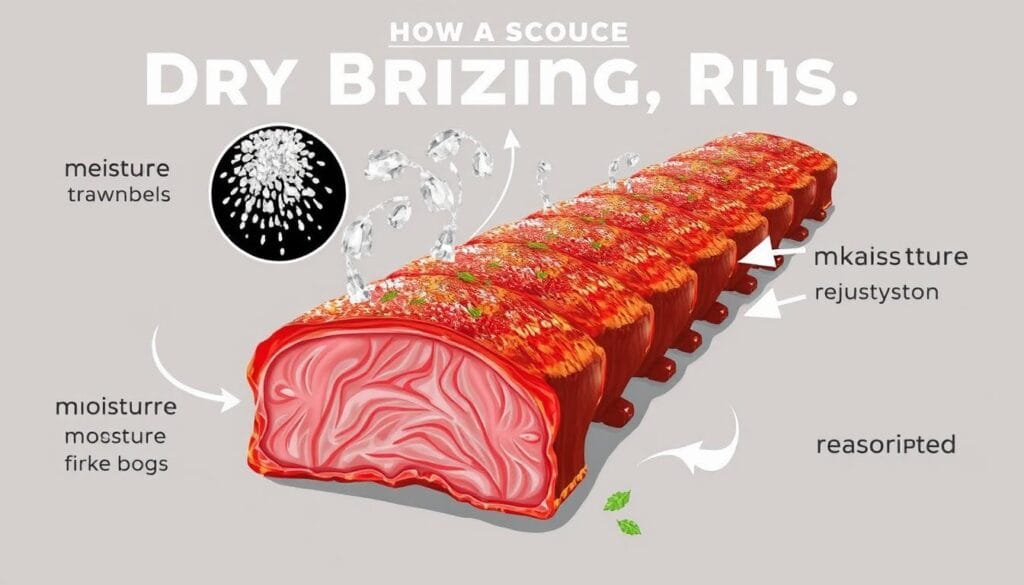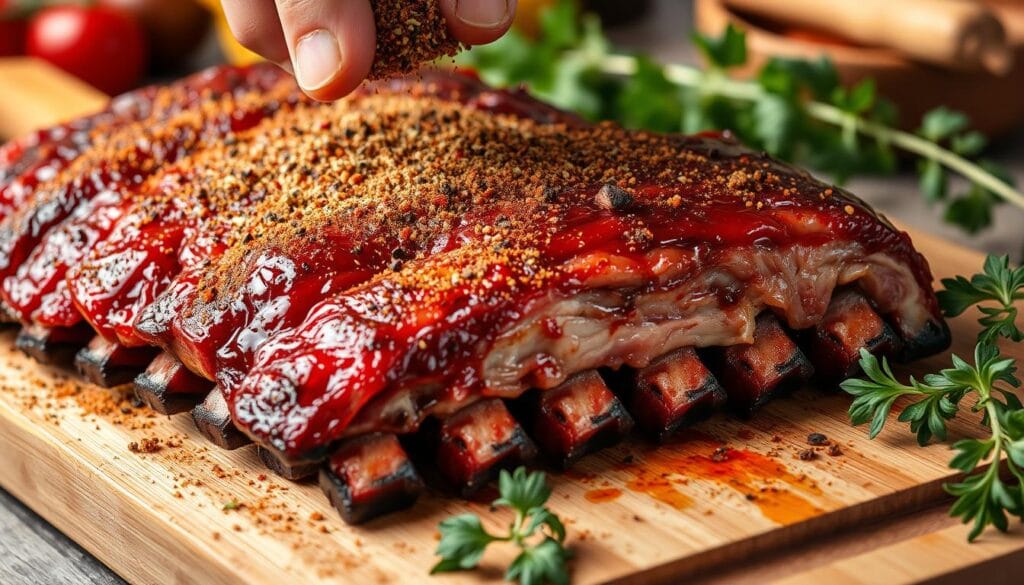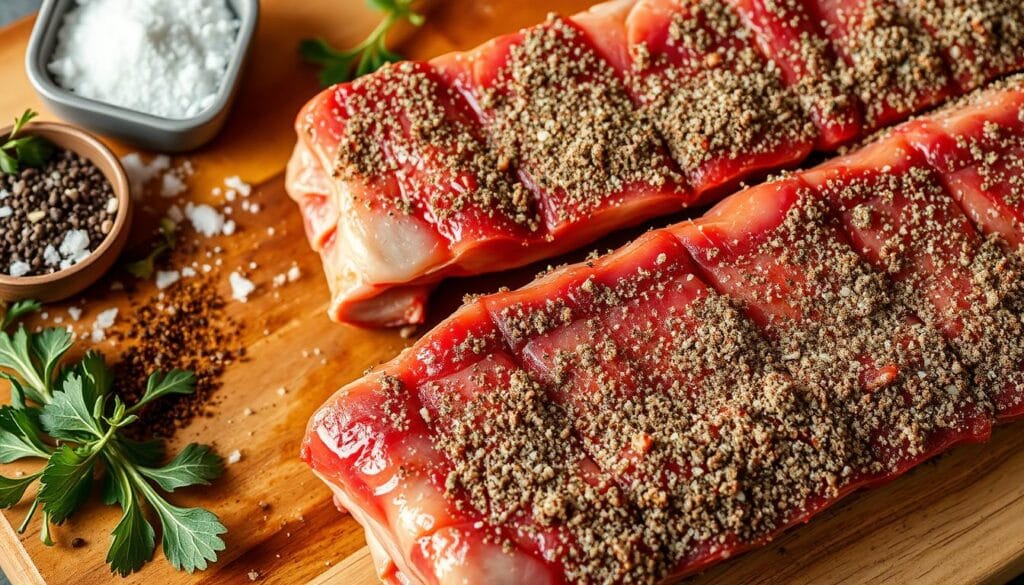I’ve spent many weekends trying out different ways to cook ribs. The big question is how to make them truly delicious. Dry brining ribs after seasoning is not just a cooking trick. It’s a skill that can make your BBQ unforgettable.
Dry brining ribs is simple yet powerful. It works for both experienced grillers and beginners. It’s not just about adding spices. It’s about creating a flavor that will impress everyone.
Many people ask if they can dry brine ribs after seasoning. The answer is yes, but it needs to be done right. You use salt to pull out moisture, then it gets reabsorbed. This makes the meat taste better and become more tender.
Table of contents
- Understanding Dry Brining
- The Science Behind Dry Brining
- When to Apply Seasoning and Dry Brine
- Step-by-Step Guide to Dry Brining Ribs
- Essential Tips for Perfectly Brined Ribs
- Can i dry brine ribs after seasoning After Adding Other Seasonings?
- Types of can i dry brine ribs after seasoning
- Cooking Methods for Brined Ribs – can i dry brine ribs after seasoning
- How to Gauge the Effectiveness of Dry Brining
- Serving Suggestions for Your Brined Ribs
- Storing Leftover Brined Ribs
- Conclusion: Enhancing Your Rib Cooking Experience
Understanding Dry Brining
Dry brining is a technique that changes how you prepare ribs. It’s a simple yet powerful way to boost meat flavor and texture. Unlike wet brining, dry brining uses salt directly on the meat’s surface.

What is Dry Brining?
Dry brining is a cooking method where you rub salt on the meat. It makes your ribs taste amazing by drawing out moisture and concentrating flavors. Both chefs and home cooks love it for its easy steps and great results.
How Does Dry Brining Work?
When you put salt on the meat, a cool science happens. The salt pulls moisture out, turning into a brine. Then, this brine goes back into the meat, bringing salt deep into the fibers. Here’s what works best:
- Optimal dry brining time: 12 to 48 hours
- Recommended salt quantity: Thin, even layer
- Refrigeration temperature: Between 34-40°F
Benefits of Dry Brining Ribs
Dry brining ribs has many benefits:
- Enhanced moisture retention
- Deeper flavor penetration
- Crispier exterior when cooked
- More concentrated meat flavor
“Dry brining is like a flavor magic trick for your ribs” – Professional BBQ Chef
Learning and using the dry brine technique can make your rib cooking amazing. It might seem easy, but the results are truly impressive.
The Science Behind Dry Brining
Learning about dry brining can make your cooking ribs amazing. It’s a method that uses salt’s special properties to improve meat quality.

Dry brining is more than just seasoning. When you put salt on ribs, a cool osmosis process starts. This process helps keep the meat moist, making dry brining better than wet brining.
Osmosis and Moisture Retention
Salt works its magic in a scientific way. Here’s what happens:
- Salt pulls moisture from the meat’s inside
- Dissolved proteins form a protective layer
- Moisture spreads evenly through the meat
- Proteins reorganize, keeping liquid inside
Salt’s Role in Flavor Enhancement
Salt also boosts flavor. 1/2 teaspoon of Morton Coarse Kosher Salt per pound of meat can change how your ribs taste.
“Salt doesn’t just make food salty—it amplifies and deepens existing flavors.” – Culinary Science Expert
| Dry Brining Component | Impact on Meat |
|---|---|
| Salt Concentration | Protein Modification |
| Brining Duration | Moisture Retention |
| Protein Denaturation | Texture Improvement |
By grasping these scientific facts, you can make your rib cooking better. The secret is to be precise and patient with your dry brining.
When to Apply Seasoning and Dry Brine
Getting BBQ ribs just right takes timing and skill. Knowing when to season and dry brine is key. Many pitmasters wonder: Should you season before or after dry brining?

Great ribs start with the right prep. Dry brining works best with a certain method. Most say to season your ribs before dry brining to get the most flavor.
Optimal Seasoning Timing
Here are the important steps for your ribs:
- Remove the membrane from the back of the ribs
- Apply a generous salt-based dry rub
- Let ribs rest in the fridge for 12-48 hours
Best Practices for Rib Preparation
The time you dry brine affects flavor and tenderness. Chefs suggest a minimum of 12 for the best taste.
| Rib Type | Recommended Dry Brine Time | Best Seasoning Approach |
|---|---|---|
| Baby Back Ribs | 12-24 hours | Salt-based dry rub before brining |
| Spare Ribs | 24-36 hours | Complex spice blend before brining |
| St. Louis Style Ribs | 18-30 hours | Balanced seasoning before dry brine |
“Patience is the secret ingredient in perfect BBQ ribs” – Pitmaster’s Wisdom
Each rib type needs a bit of tweaking in prep. Try different times and seasonings to find your favorite way.
Step-by-Step Guide to Dry Brining Ribs
Learning to dry brine ribs after seasoning is all about precision and technique. With the right approach, your ribs recipe can go from good to amazing.

Dry brining is a method that changes the game for ribs. It uses salt to boost the meat’s natural flavors and keep it juicy.
Selecting the Perfect Salt
Choosing the right salt is key when making your ribs recipe. Kosher salt is the best for dry brining because of its unique qualities:
- Large, flaky crystals that stick well to meat
- Evenly spreads across the rib surface
- Less likely to over-salt compared to fine table salt
Proper Dry Brining Technique
Here’s how to dry brine ribs after seasoning:
- Pat the ribs dry with paper towels
- Sprinkle kosher salt evenly over the entire surface
- Use about 1/2 teaspoon of salt per pound of ribs
- Put ribs uncovered in the fridge
- Let them rest for 12-24 hours before cooking
“The secret to exceptional ribs lies in the details of your dry brining technique.” – BBQ Experts
By following these steps, you’ll make your ribs recipe top-notch. They’ll be full of flavor and tender.
Essential Tips for Perfectly Brined Ribs
Mastering dry brining ribs needs precision and detail. Your journey to delicious ribs starts with understanding key techniques. Cooking ribs becomes an art with these expert tips.
Recommended Brining Durations
The secret to perfect dry brining is timing. Different rib cuts need different brining times:
- Baby Back Ribs: 2-4 hours
- Spare Ribs: 4-6 hours
- St. Louis Style Ribs: 3-5 hours

Common Mistakes to Avoid
When dry brining ribs, avoid these mistakes:
- Oversalting your meat
- Not allowing enough resting time
- Skipping the pat-dry step before cooking
“Patience is the secret ingredient in perfect dry brining.” – BBQ Maestro
| Rib Type | Ideal Brining Time | Salt Quantity |
|---|---|---|
| Baby Back | 2-4 hours | 1/2 tsp per pound |
| Spare Ribs | 4-6 hours | 3/4 tsp per pound |
| St. Louis Style | 3-5 hours | 2/3 tsp per pound |
Remember, dry brining ribs is about boosting natural flavors. Each cut needs a unique approach. Experiment to find your perfect method.
Can i dry brine ribs after seasoning After Adding Other Seasonings?
When cooking ribs, knowing how to season and dry brine is key. Many people ask if they can dry brine ribs after seasoning.
Seasoning ribs needs careful timing and technique. The order of salt application greatly affects flavor and texture.
Understanding Flavor Interactions
Salt is vital for flavor penetration. When dry brining, remember these important points:
- Salt helps keep moisture in
- Draws out protein enzymes
- Boosts natural meat flavors
Optimal Seasoning Combinations
Trying different seasoning combinations is important. Professional chefs suggest these tips:
- Put salt on first for better penetration
- Wait 2-4 hours before adding spices
- Don’t over-salt to avoid flavor mess
| Seasoning Stage | Recommended Approach |
|---|---|
| Initial Salt Application | Directly on meat surface |
| Secondary Seasoning | Dry herbs and spice blends |
| Final Touch | Wet rubs or marinades |
“The secret to perfect ribs lies in understanding salt’s transformative power.” – BBQ Master Chef
Timing and technique are key when exploring dry brining ribs after seasoning. Each method brings unique flavors and textures.
Types of can i dry brine ribs after seasoning
Dry brining ribs can make your BBQ taste better and feel softer. Each rib type has its own special traits that change how you brine. Knowing these differences helps you get great results every time.
When picking ribs for dry brining, you’ll find three main types. Each has its own special features:
Baby Back Ribs
Baby back ribs are lean and tender, perfect for dry brining. These smaller ribs:
- Cook faster than other cuts
- Require about 10 minutes less cooking time
- Soak up seasonings quickly
Spare Ribs
Spare ribs have more fat and meat, giving them a deep flavor. They stand out because:
- They have more fat
- Need longer cooking times
- Have a meatier texture
St. Louis Style Ribs
St. Louis style ribs are trimmed spare ribs with a uniform shape. They’re great for dry brining because:
- They have even meat
- Soak up seasonings well
- Work well with many cooking methods
“Choosing the right rib cut is essential for perfecting your dry brining technique.” – BBQ Experts
Each rib type reacts differently to dry brining. So, try different methods to find what you like best. The key is to understand how salt works with different meats and fats.
Cooking Methods for Brined Ribs – can i dry brine ribs after seasoning
Choosing the right cooking method can make your dry-brined ribs amazing. The method you pick will greatly affect the taste, texture, and enjoyment of your BBQ ribs.
There are many great ways to cook ribs, each with its own special touch. These methods ensure your meal is not only delicious but also memorable.
Grilling: The Classic BBQ Approach
Grilling is a traditional way to cook ribs, bringing out intense flavors. The heat creates a caramelized outside and keeps the inside juicy.
- Optimal grill temperature: 225-250°F
- Cooking duration: 4-6 hours
- Perfect for achieving smoky flavor profiles
Smoking: Low and Slow Perfection
Smoking ribs gives them deep flavors and tender meat. Specialized smokers create an environment that turns tough meat into a culinary masterpiece.
| Smoking Method | Temperature | Time |
|---|---|---|
| Electric Smoker | 225°F | 5-6 hours |
| Charcoal Smoker | 250°F | 4-5 hours |
Baking: Convenient Indoor Alternative
Oven baking is a consistent method for those without outdoor grilling. It might not have the smoky taste, but the right seasoning can make it delicious.
“The secret to great ribs is patience and proper temperature control, regardless of your cooking method.”
Remember, dry brining prepares your ribs for maximum flavor and tenderness. Your cooking method will take those perfectly seasoned ribs to a whole new level of enjoyment.
How to Gauge the Effectiveness of Dry Brining
Mastering the dry brine method needs keen observation and understanding. It changes your ribs in ways you can feel and see. This technique does more than just season the meat; it makes a big difference in how it tastes and feels.
Texture and Moisture Assessment
- Check for increased meat tenderness
- Observe the meat’s surface moisture
- Compare texture with previous unbrined preparations
Visual Indicators of Successful Brining
Good brined ribs show clear signs of success:
- Slightly darker meat surface
- Uniform salt distribution
- Subtle sheen indicating moisture retention
| Brining Indicator | Positive Sign | Negative Sign |
|---|---|---|
| Surface Appearance | Even, slightly glossy | Dry, uneven coloration |
| Meat Texture | Tender, juicy | Tough, stringy |
| Flavor Depth | Rich, well-seasoned | Bland, underseasoned |
Remember, mastering the dry brine method takes time. Each try helps you get better at making great ribs.
“Great barbecue is about precision, patience, and understanding your ingredients.” – Professional Pitmaster
By paying attention to these details, you’ll learn when your ribs are truly amazing.
Serving Suggestions for Your Brined Ribs
After perfecting your BBQ ribs recipe, choosing the right sides and sauces can make your meal amazing. Pairing your dry-brined ribs with the right dishes makes the dining experience better.
Ideal Side Dishes to Complement Ribs
Classic BBQ ribs are best with traditional Southern-style sides. Here are some favorites:
- Creamy coleslaw with a tangy vinegar dressing
- Smoky baked beans with bacon bits
- Buttery cornbread with honey butter
- Crispy potato salad with fresh herbs
- Grilled corn on the cob with chili-lime butter
Best Sauces and Glazes for Ribs
Your ribs recipe needs a great sauce to boost its flavors. Try these delicious options:
- Sweet and Tangy Kansas City-Style Sauce: Rich, molasses-based with a hint of tomato
- Spicy Carolina Mustard Glaze: Zingy and bold
- Memphis Dry Rub Style: Minimal sauce, maximum seasoning
- Texas-Inspired Bourbon BBQ Sauce: Deep, smoky flavor profile
“The right sauce can turn good BBQ ribs into an unforgettable meal.” – BBQ Pitmaster
Try these ideas to make a BBQ experience that will be remembered. It’s all about your perfectly dry-brined ribs.
Storing Leftover Brined Ribs
After you’ve perfected your ribs recipe, it’s important to store them right. This keeps their flavor and texture just right. Knowing how to store and reheat your ribs ensures you enjoy every last bite.
Refrigeration Best Practices
When storing dry-brined ribs, pay close attention to keep them moist and tasty. Proper storage techniques help keep your ribs fresh and appealing.
- Store ribs in airtight containers
- Wrap tightly in aluminum foil or plastic wrap
- Refrigerate within 2 hours of cooking
- Consume within 3-4 days
Freezing and Long-Term Storage
Freezing is a great way to keep your ribs for longer. Make sure to wrap them well to avoid freezer burn and keep their quality.
| Storage Method | Duration | Recommended Technique |
|---|---|---|
| Refrigeration | 3-4 days | Airtight container |
| Freezing | Up to 3 months | Vacuum-sealed bag or double-wrapped |
Reheating Techniques
To revive your leftover ribs, heat them gently to avoid drying out. Low and slow is the best way to keep them juicy.
- Oven method: 250°F for 20-30 minutes
- Wrap in foil to retain moisture
- Add a splash of broth or sauce
- Use a meat thermometer to check internal temperature
“The secret to great leftover ribs is gentle reheating and preserving their original moisture.” – BBQ Experts
By following these tips, your ribs will stay as tasty as when they were first cooked. This ensures you get the most enjoyment from your meal.
FAQ
What is dry brining, and how is it different from wet brining?
Can I dry brine ribs after applying other seasonings?
How long should I dry brine ribs?
What type of salt works best for dry brining ribs?
Do I need to rinse the ribs after dry brining?
Can I dry brine different types of ribs?
What cooking methods work best for dry-brined ribs?
How does dry brining improve rib flavor and texture?
Conclusion: Enhancing Your Rib Cooking Experience
Dry brining ribs changes how you cook at home, making meals special. It lets you bring out deeper flavors and better textures in your ribs. You’ll learn how to use salt, seasonings, and cooking methods to make dishes that taste like they’re from a restaurant.
Key Insights Revisited
Learning to cook ribs with dry brining shows you important things. Salt is key for keeping ribs moist and adding flavor. No matter if you’re cooking baby back or spare ribs, the basics are the same: use salt right, season well, and control the heat.
Your Culinary Adventure
Try new things with dry brining ribs. Every time you cook, you can get better, try different seasonings, and find your own style. Begin with some advice, but feel free to make it your own. The best dishes come from trying new things and learning from each attempt.

